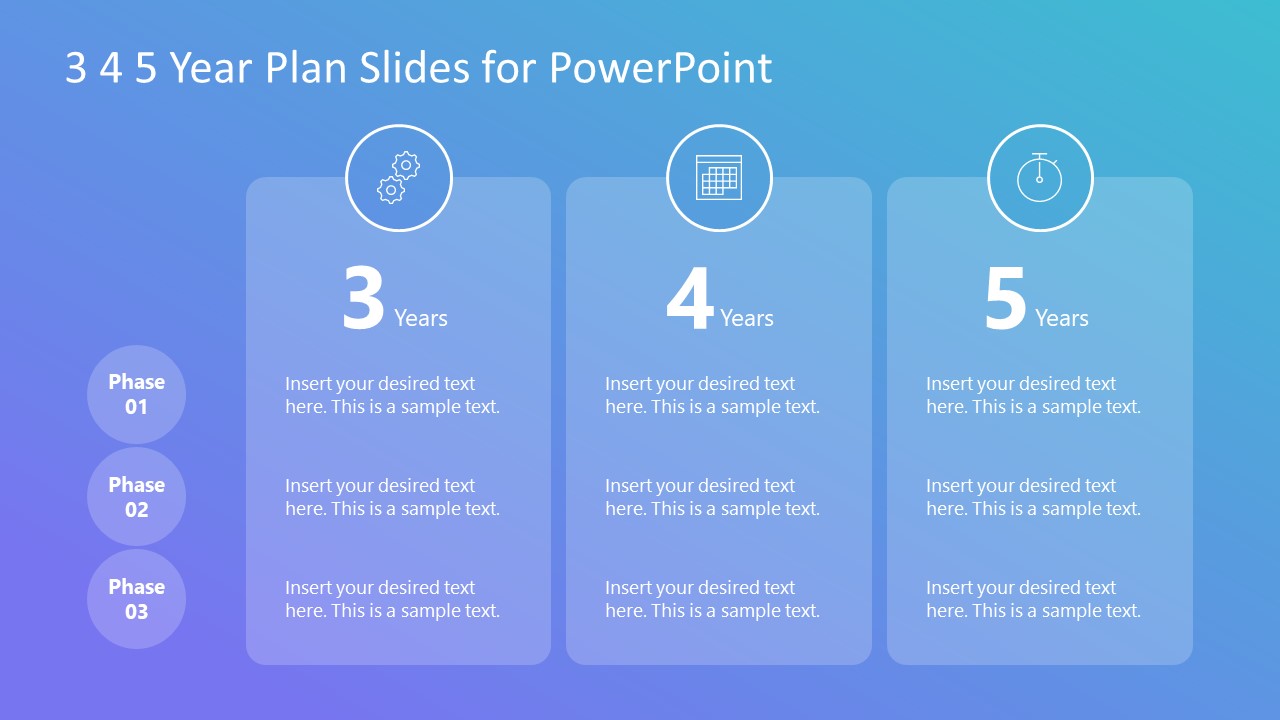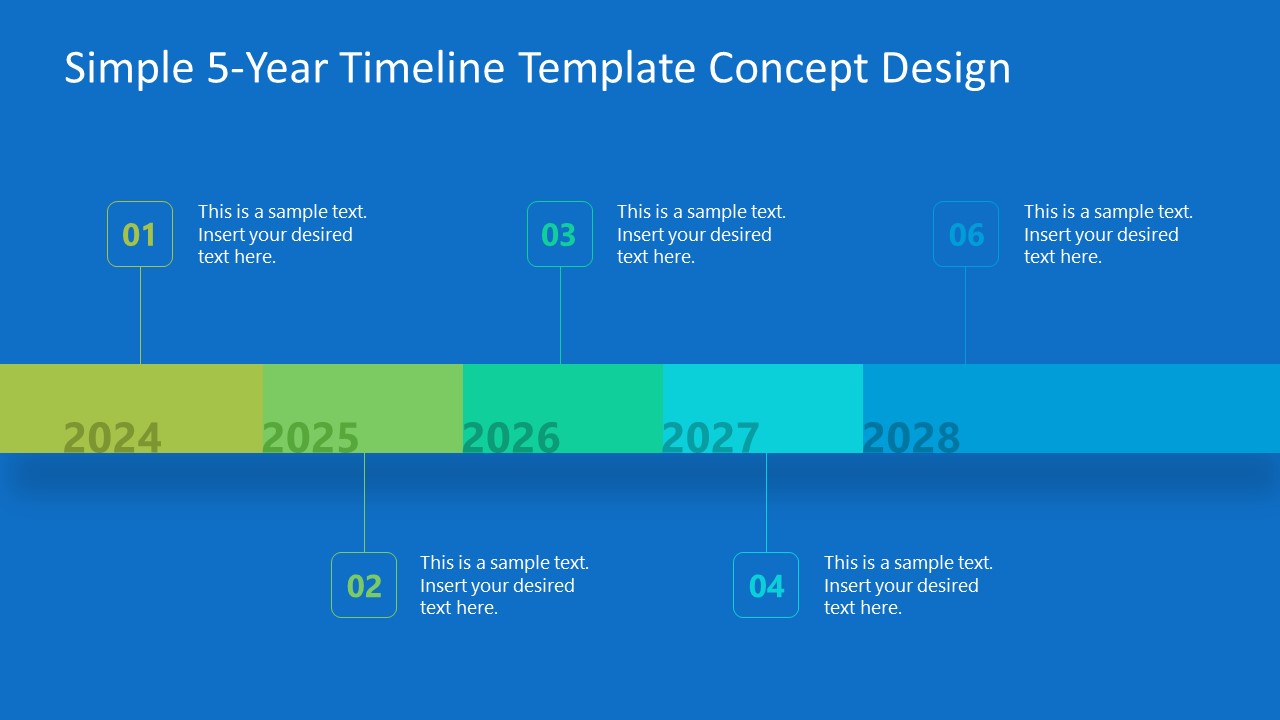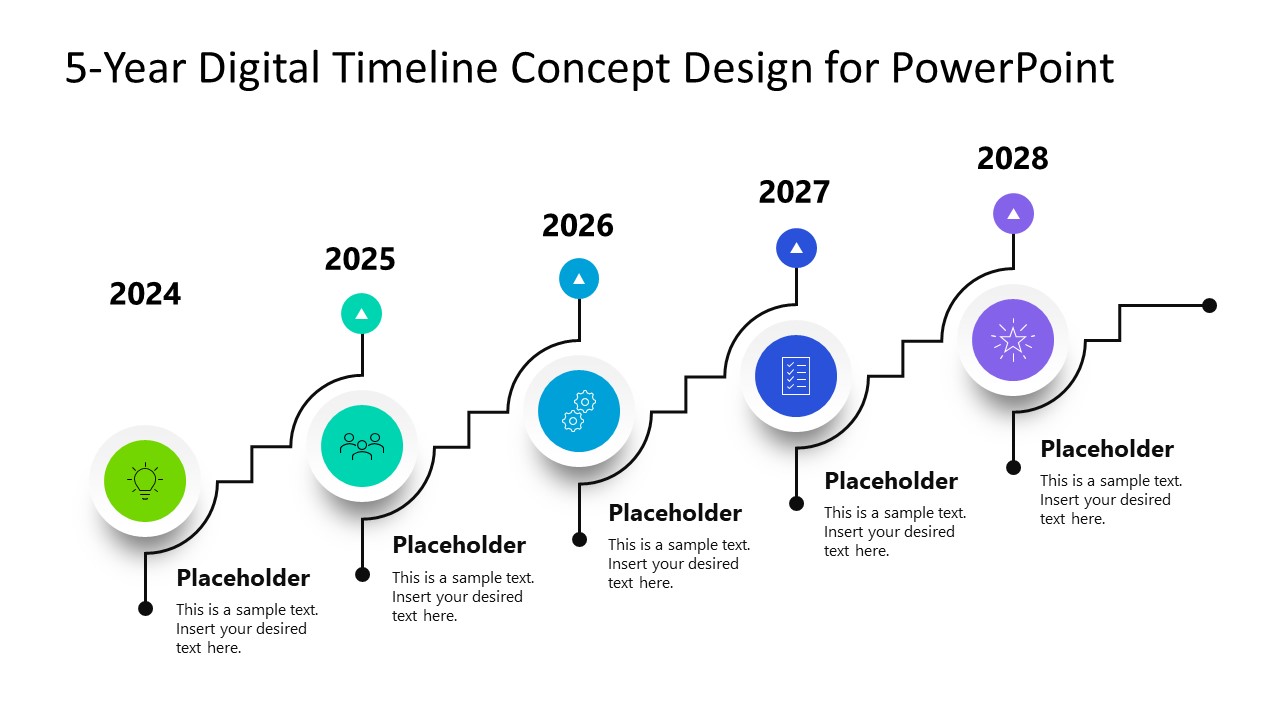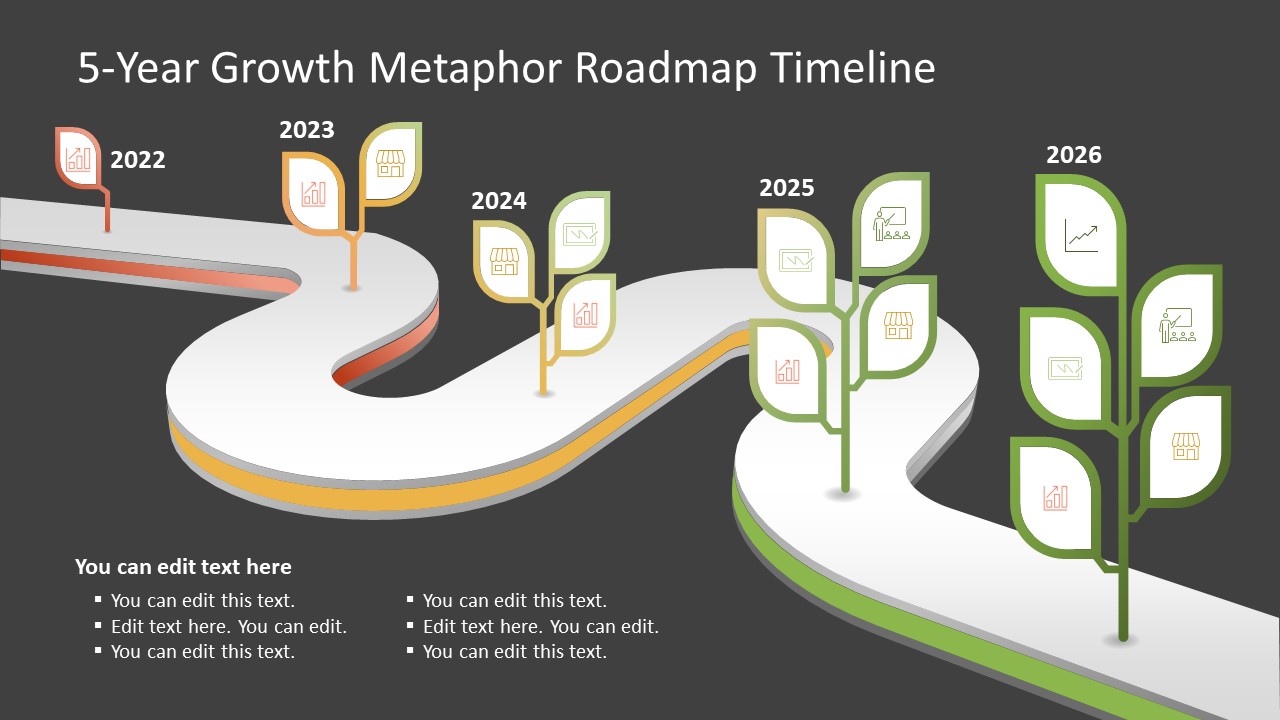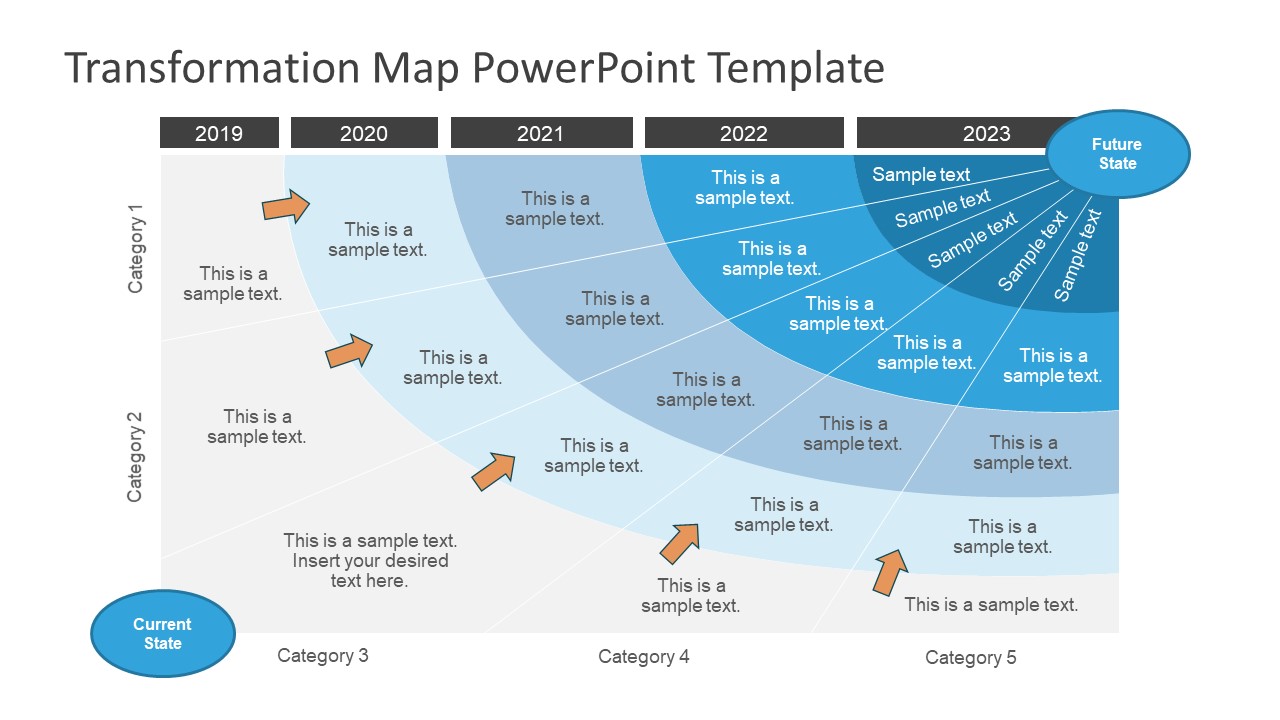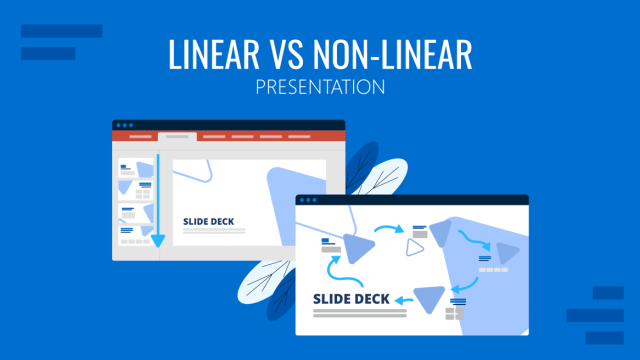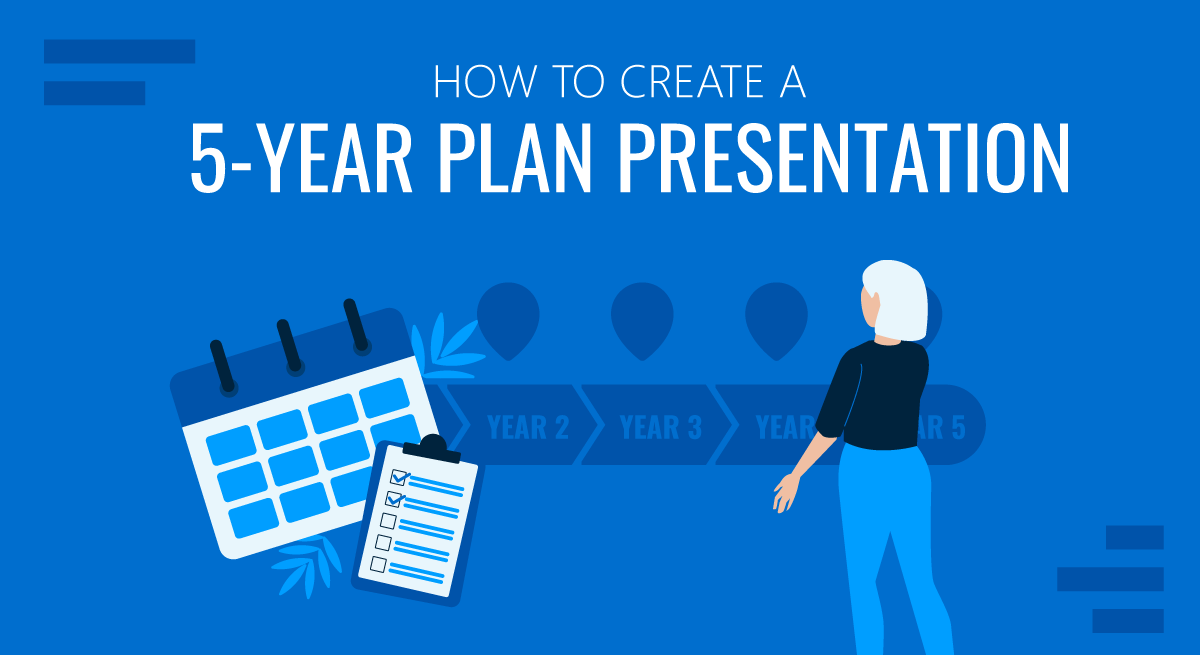
A crucial stage for career development is to set your eyes on future goals that may enrich your path to success. For that reason, there are multiple planning models: from amateurish approaches such as writing down your ideas in a journal to taking up a carefully planned roadmap.
In this article, we will discuss one of the models for career development planning known as the 5-Year Plan model, its core purpose, the advantages, and disadvantages of implementing this model into your life, and giving you a step-by-step guide for crafting your own 5-Year plan.
In the final section of this article, you can find some real-case applications of this planning model and suggested templates created by our team to make this process easier.
Table of Contents
- What is a 5-Year Plan?
- Benefits of creating a 5-Year plan
- Disadvantages of 5-Year plans in career development
- How to create a 5-Year Plan
- How to present your 5-Year plan
- Final Thoughts
- Selected 5-Year Plan Presentation templates for PowerPoint
What is a 5-Year plan?
When discussing a 5-Year plan, we refer to a compendium of goals that attain your personal and professional life, which you wish to achieve within the next five years. It is a medium-term planning model with a concrete framework to measure the progress towards those goals.
It is common to see plans that list personal and professional goals since some personal goals can shape the outcome of your professional life. For example: overcoming performance anxiety, improving your time management skills, learning a new language, etc. You get the point.
The purpose of 5-Year plans
A survey conducted by Deloitte in June 2020 concluded that almost half of Millennials and the Gen-Z population are affected by anxiety or severe stress. Whereas this realization could be a direct consequence of what was seen during the COVID-19 lockdowns, reality tells us anxiety among the younger population is driven by a lack of clear goals, uncertainty about the future, and social expectations that force us to see happiness in anything but “success.”
So then, what is the purpose of the 5-year plans? The endgame of this planning model is to see yourself in five years, what you wish to achieve – that being either income goals, graduating, seeking a Ph.D., relocating, investing in your own business, etc. Then list down the required steps to make those big dreams a reality within 5 years. As clear as that.
Measuring Progress
Accountability is a vital ingredient of success. Taking ownership of your actions may seem the answer to everything, but if we don’t measure where we stand, how far we have gone, and the setbacks we had, any plan crafted is doomed to failure.
Measuring progress implies setting milestones for your 5-year plan with reasonable deadlines, recording the start date, how many hours per day you can allocate for the task, and how many are needed to make significant progress. You can even be as detailed as to track the following points:
- People involved in the task/goal to complete
- Investment required to accomplish the goal
- Any ideas that can improve your performance for the goal
- Feedback from friends, family, or colleagues
The question then becomes: how to actually measure the progress towards those goals? Let’s define some models for this:
- Incremental Milestones: To apply this method, you need to calculate the amount of time required to complete the goal. Define mini-steps to reach the final milestone, assigning them the proper workload required. As you complete a step of this milestone, you record the progress manually or via a time-tracker app, which would be the percentage of completeness for your goal.
- Units Completed: This method works for goals that involve repetitive tasks. Say you aim to write 10 articles per week as your career development goal for the month. Then, you know that 10/10 equals completing the goal and that you start from 0/10. Despite being an easy method to apply, you can fall prey to not setting deadlines for this, hence not feeling progress.
- HARD Goals: A concept introduced by Mark Murphy in his 2009 book “Hundred Percenters,” the HARD goal is an acronym composed by:
- H for Heartfelt: Refers to the emotional attachment to the goal, considering in which direction it pulls you. The stronger your emotional bond to this goal, the more likely you will accomplish it.
- A for Animated: Goal setting doesn’t imply pen and paper to list down things. Animating your goals means considering how your life will be once the goal is achieved. This concept is coined by most life coaches in the power of visualization techniques, mood boards, and attracting what you want in life.
- R for Required: The absolute essentials for success. Those elements you cannot ignore in your path to completing a goal, or it would mean catastrophe.
- D for Difficult: This measures how we need to move out of our comfort zone to succeed in this goal. The harder it seems to attain the goal, the more likely you are to postpone it.
- SMART Goals: By this point, you are already familiar with the SMART Goals model, but just in case, let’s do a brief recap of it.
- Specific: The goal needs to be significant, clear, and specific, so you feel drawn to complete it.
- Measurable: The goals require metrics to measure, so you perceive the progress of it.
- Achievable: About being realistic and setting attainable goals instead of crazy thoughts.
- Relevant: Ensuring your goals align to what truly matters to you and resonates with relevant goals already set in your life.
- Time-Bound: The time frame in which you’ll complete the goal.

Remember that you are building momentum by achieving your goals, no matter their size. As explained by Mihaly Csikszentmihalyi in his best-seller book “Flow: The Psychology of Optimal Experience,” once your goals are realistic and your skills align with the difficulty of the task, you enter into “flow” mode, a state of mind in which you feel so involved with the task that you lose track of time. You don’t experience resistance to continue working towards your goals but sense it as an element towards happiness.
Benefits of creating a 5 -Year plan
Since many of us relate to spending entire afternoons in in-depth planning sessions just for the joy of it, for those who disagree with that statement, it’s best to lay out the benefits of a well-made 5-year plan.
A roadmap for career success
The first advantage of working with a 5-year plan is creating an accurate roadmap for what you aim to succeed in in the upcoming 5 years. Therefore, you keep tracking each year the number of goals to accomplish, how well you managed to perform, and which areas to improve or revisit.
It’s not simply stating you wish to do something but taking action towards your future.
Defining focus
The best thing about this planning model is that you won’t divert your attention from the tasks at hand. These 5-year plans help you set your priorities straight: what matters to you the most, how will you allocate time per task/goal, and also provides a valid reason to say “no” to extra assignments that don’t align with your vision.
Motivation for achieving career goals
Finally, in this set of benefits of 5-year plans, we should highlight the role of career goals, as students often feel overwhelmed when starting a university degree about the workload that’s just around the corner.
With a carefully crafted 5-year plan, you can split the necessary items into different areas with clearly-defined effort levels and track your progress towards that end goal. Again, this relates to building momentum and reaching a flow state of mind, but if you are going through a rough time, give yourself time to look at your plan and see how far you have gone by your sole effort.
Disadvantages of 5-Year plans in career development
Not everything can go as beautifully as planned. Hence we need to be aware of the side effects that solely relying on 5-year plans can have on our personal development.
Staying in “tunnel-vision” mode
A strict planning model’s most common side effect is to end up in what’s known as “tunnel-vision,” meaning you lack the perspective to see what might be happening around you.
This is a problem since not always everything goes as planned, and isolating your personal/professional goals ends up building frustration since you can consider activities outside the schedule a “waste of time/effort” when you are just living life as everyone else.
Pent-up frustration slowly turns into burnout, so watch out for the early signs as a word of advice.
When “life happens”
Related to the point mentioned above, life does happen. We can experience setbacks by either people, technology, health situations, and multiple scenarios that alter what was scheduled and the plans that followed.
The first step towards this is to accept life as a reality. If things were as simple as just creating an action plan and following it, people wouldn’t be complaining about their situation. We would live in a utopia and not realize the effort it takes to accomplish a project or fulfill a goal.
Next, don’t be so harsh on yourself, as setbacks are part of life. Instead, look for the teachings you can get out of these situations and apply them when you revisit your plan’s progress.
Lack of support for obtaining our goals
Although it’s not commonly seen, it is a possibility that your loved ones don’t understand your passion and commitment to this 5-year plan. Instead of falling prey to resentment, opt to explain why this planning matters to you. Why do you feel it can bring a significant change into your life and turn both your personal and professional life for the better.
If building the 5-Year plan is required by your career counselor or the HR department as part of a career-building program, see this as an opportunity to rehearse your presentation in front of a live audience.
How to create a 5-Year Plan
In this section, we’ll go through the steps that make a solid 5-year plan for career development.
Defining your key points
Target which areas your plan should cover. We often want to do it all, and that can be counterproductive. Instead, make a manageable list like this one:
- Personal Life: Where do you want to be in the next 5-years? Where would you live? Do you envision a partner and children? A certain income?
- Career: Set your eyes on which career path you desire to pursue, the education assets required to get your dream job, and the soft skills to develop to guarantee success in interviews and daily work life.
- Investments: Does your career path require you to invest hefty sums? That’s often the case in creative jobs as photographers, CGI artists, and entrepreneurs releasing a product. If so, tame this situation by budgeting, researching methods to fund your career goals, etc. A 5-Year Budget Plan template can give you a visual approach to see where you stand now, the objectives, and the budget to cover.
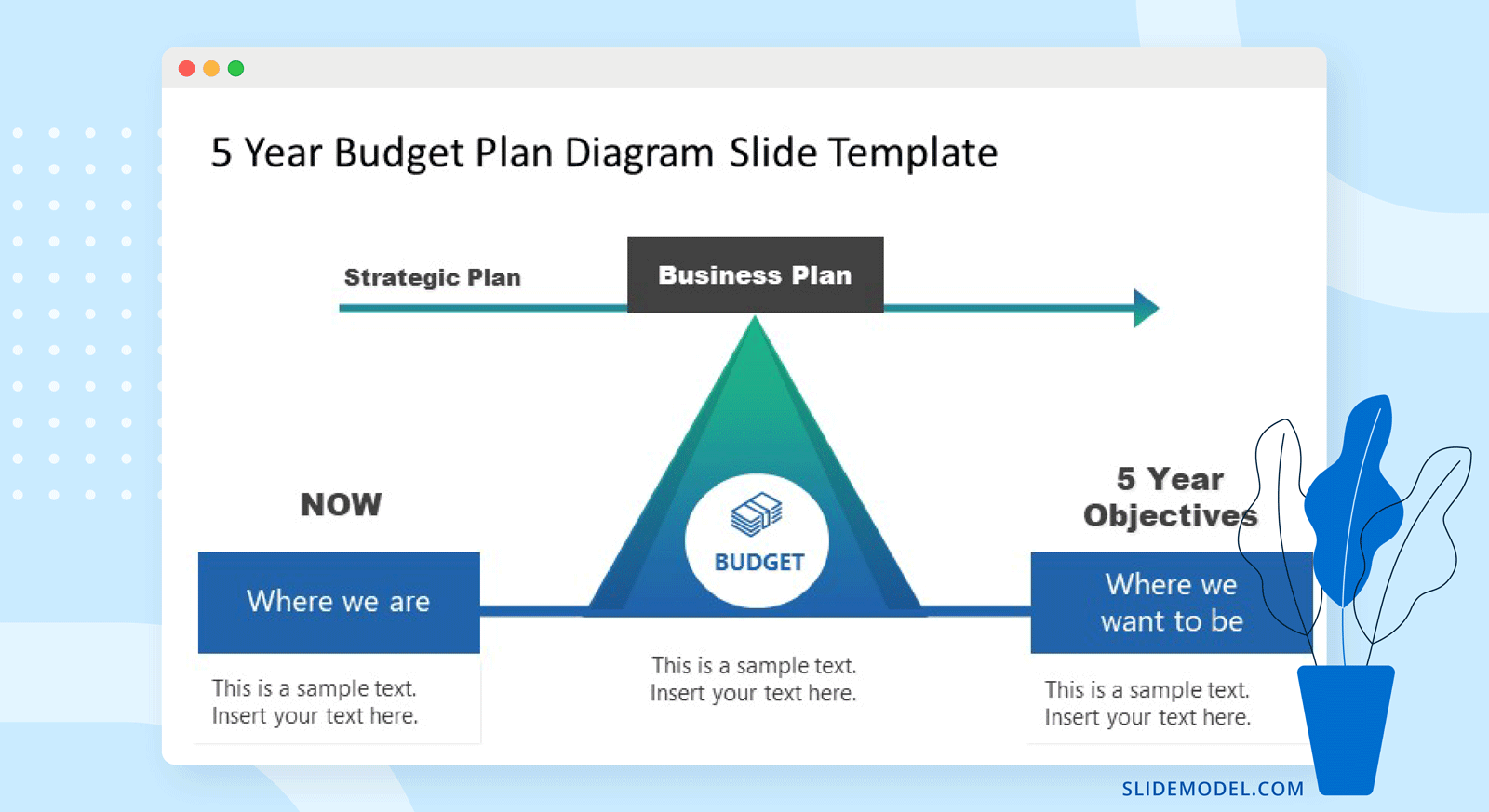
- Recreation: Schedule time to do activities outside your career goals. This is crucial to avoid burnout, so allocating time for your hobbies, vacations, family time, meetings with friends, and more it’s not a waste of time; it’s something essential for a proper life/work balance.
Listing your goals
After defining your key areas, list the goals pertinent to each. Don’t just stick to listing them down. Take the effort to apply a progress measuring method such as converting your goals to SMART Goals.
List your current skills and experience since many of your goals may require a skillset outside your comfort zone. That gives room to plan training sessions to build the skills needed per goal.
Examining your “Why”
After all your goals, skills and areas are defined, it’s time to deeply examine each one of them related to your “Why.” Why do you do what you do? Why do you feel drawn to certain areas or particular interests?
The first step toward this “Why” questioning process is to establish why you want to build a 5-year plan in the first place. Why do you feel this planning method can impact your professional life. Then ask yourself why you desire to make a change and set goals for your career life. What’s the end goal you pursue? Is it financial freedom? Career recognition? Do you just desire to retire early to spend more time with your loved ones?
Those are questions that undoubtedly move invisible threads that make things happen. They can be the driving force behind your daily life, and you may not even be aware of that.
The second area of importance for this, and Simon Sinek clearly states it in his 2009 book “Start with Why: How Great Leaders Inspire Everyone to Take Action”:
“People don’t buy what you do, they buy why you do it. And what you do simply proves what you believe.”
Simon Sinek
You need to know why you pursue specific goals for your professional life and career growth if you aim to build a company. You have to convince your potential customers why you believe your product/service is the best element to solve their problems. Companies like Digital Silk have successfully demonstrated this by consistently delivering innovative solutions that address customer needs and surpass expectations. This process goes all the way back to the very first moment you set your path towards career development growth. Someone who doesn’t even know why they were inspired to create something certainly will lack the force to convince people about acquiring it.
Research and constant learning
This 5-year plan process will force you to research the areas where you lack knowledge, but this is not something you do one day and stay where you are. Constant learning is vital to ensure your career growth and your development as a human being.
Get in the mindset of a scholar, always drawn into research what they don’t know. That way, you can find the gaps in your knowledge and work your way to refine your plan for a better outcome.
Revisiting your plan
This final step is akin to the step shown above since by developing that constant learning mindset, you can revisit your plan effectively.
Do this process each 3-6 months. That way, you won’t become another victim of the “New Year’s Resolution Syndrome.” Revisit your notes to see where your plan drifted off its original course, what could have been done in a better manner, and what stellar results were.
Fix those blank spaces in your plan that you consider wasted opportunities, and set your sights for the next 3-6 months.
How to present your 5-Year plan
Now let’s consider what happens when we have to present this 5-year plan to either career counselors,
Selecting the template
This process’s first step is selecting a template that fits your needs. In the final section of this article, you can find a selection of templates tailored for 5-Year Plan presentations.
Using templates can save countless hours of time since these slides already offer the essential elements to accompany your presentation topic. From icons, graphs, defined text areas, etc. these templates also save us the hurdle of going through font-pairing analysis, preparing color matching schemes, or worrying about overloading the presentation with information.
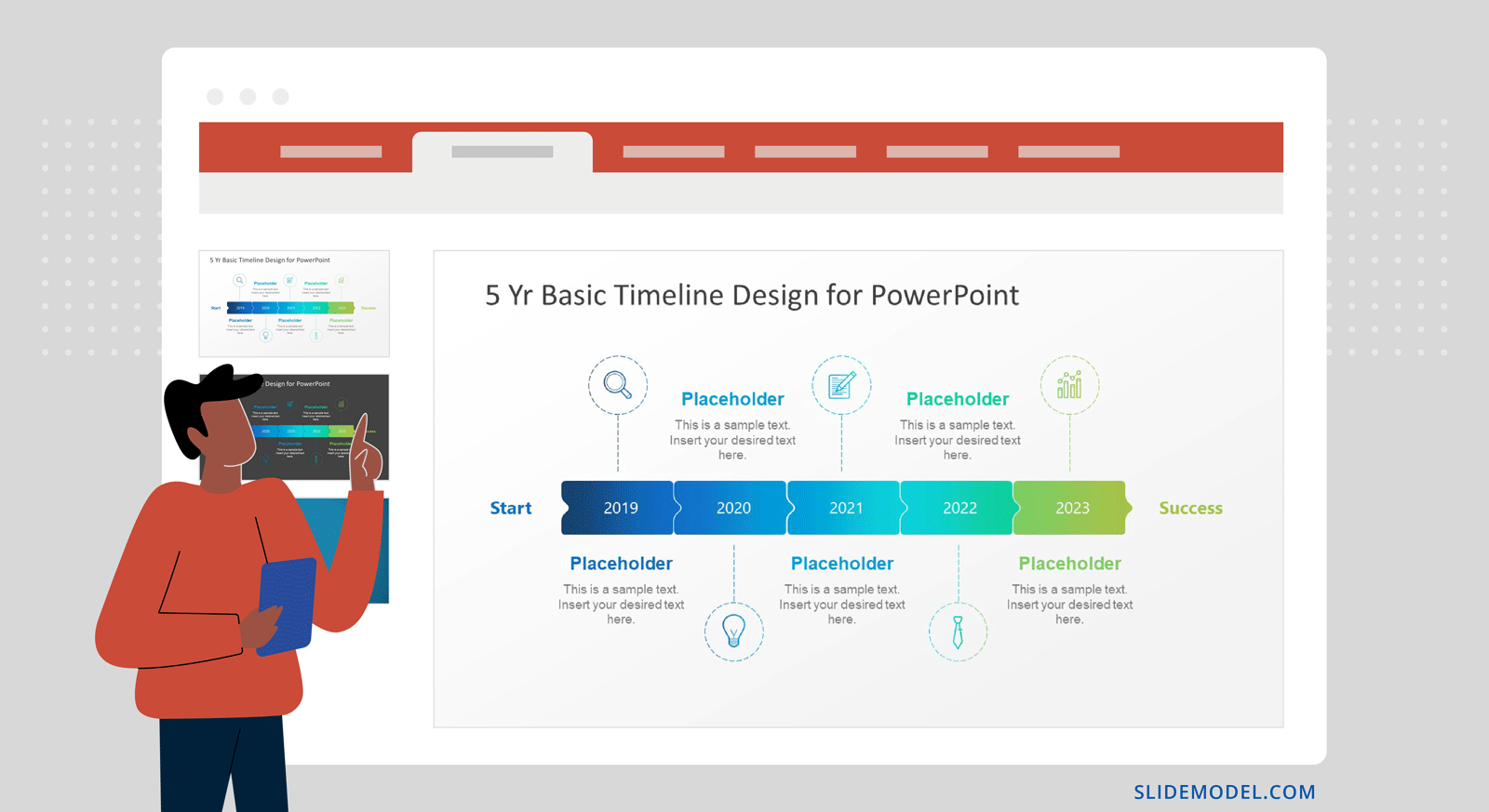
Which elements to include in a 5-Year plan presentation
The following items must be included for a stellar 5-Year plan presentation:
- Your “Why”: What drove you to make the 5-Year Plan, why do you consider it will help your career, etc.
- Timeline of events: To brief about which major milestones shall happen each year and how they will shape your career’s outcome.
- List of goals sorted by area, defining complexity level, and their deadline.
- The people involved as support resources to make your goals achievable.
- The budget range you need to invest in for these goals to be attainable, methods of financing the investment, and how to cover potential contingencies.
- How will you measure your goals’ progress and success rate.
Case Study for Creating a 5-Year Plan
For this case study, we are going to create a 5-year plan for a professional that seeks to transform her passion for illustration into a profitable business, as well as targeting other personal life goals.
Step 1 – Defining the Key Points
Let’s assume our role persona for this exercise has defined these key points to improve her life in the upcoming 5 years period:
- Personal Life
- Live in the same city, consider buying a new home.
- Achieve financial freedom for myself and my relatives. Have a retirement fund.
- Career
- Multiple sources of income.
- Monetize my passion for illustration (graphic design? / traditional art?)
- Work on overcoming fear of failure.
- Don’t settle for office work.
- Investments
- A new, powerful computer for CGI.
- Wacom Cintiq 13″.
- Home-Office renovation.
- Art supplies.
- Recreation
- Being able to travel abroad for vacations.
- Videogames.
- Practice photography during weekends.
- Lunch or Dinner with friends twice a month.
Step 2 – Listing your goals
After creating the list of key areas to work on, our friend has to set achievable goals for each of those areas, each of them with a deadline. Therefore, she opted for the SMART model to track her objectives.
SMART Goals to create:
- Turning my passion for illustration into a profitable business by January 11th, 2026.
- Save 30% of my income for retirement by the end of each month.
- Save 10% of my income for investments by the end of each month.
- Pay all debt using the Debt-Snowball method within one year.
- Complete my home-office renovation by October 20th, 2023.
- Meditate and learn why the fear of failure is getting in the way of my goals. Seek professional help if required, and achieve this goal as the first New Year Resolution to complete in 2023.
- Work on a healthy work/life balance, with weekly evaluations to see where I drift off.
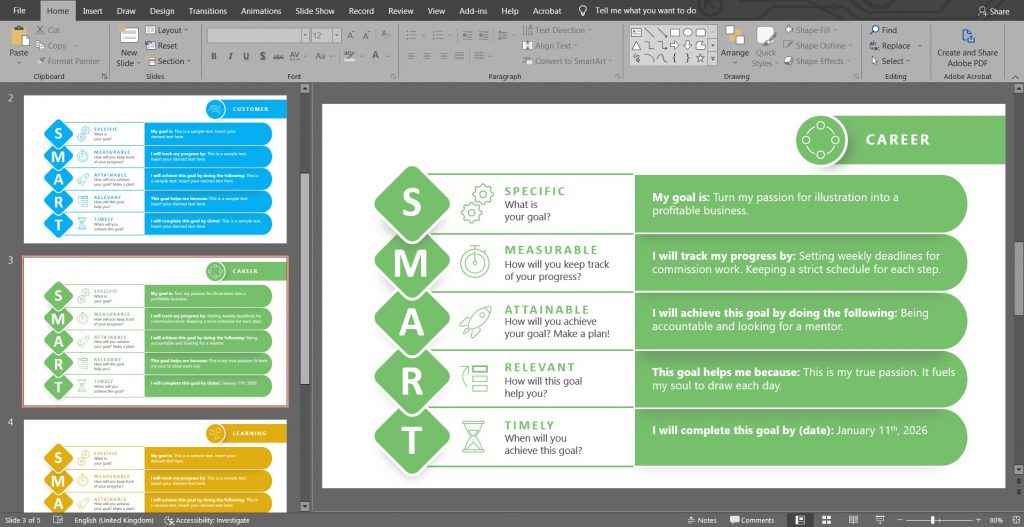
Current Skillset:
- Advanced Photoshop user / Intermediate Illustrator user
- Great sense of color combination schemes
- Gets easily inspired to work with different types of art supplies
- Avid learner
Step 3 – Examine your Why
Since it’s pretty obvious this person loves art, and she aims to build a business out of it, here are the reasons that back said decision:
- “I keep finding excuses not to draw each day”
- “Sometimes ‘work’ interferes with my creativity”
- “Painting makes me feel thrilled and I lose track of time”
- “Painting helps me to cope with anxiety”
- “By building multiple sources of income, especially passive ones, I’m taking off the pressure of making my art business the one in charge to bring food to the table”
- “If I have no debts, savings, earnings, there’s no excuse to keep refraining from doing what I truly love”
So, from this perspective, it’s not a common goal but a motivator for a better life in multiple aspects: mental health, income, home financials, time management, etc.
This is the reason why you should go through each of those goals you set and examine what comes up, see if there are any conflicts, and go through it again until it doesn’t feel like an imposition but something you truly desire to achieve.
Step 4 – Research and constant learning
The fourth step on this list applies to our role person as she needs to evaluate the current skills she has, where she desires to see herself in 5 years, and what’s needed to get there.
One extremely useful method for this is to turn your time on social media binging into learning time for your goals. Follow accounts that enrich your knowledge for the goal you’re tackling. Research on which sites may offer mentorship programs. All of these options are valid as long as you constantly question where you stand and how far you see yourself from successful-you.
Step 5 – Revisiting your plan
After this woman built her entire plan, with a proper timeline to arrange the goals intended within 5 years, she has to revisit it each 3 months to evaluate her process.
Though some goals are easy to track on a monthly basis (i.e.: saving money for retirement and investments), others require time to show progress.
For this purpose, she scheduled an entire evening every 3 months to go through her plan, see where she improved, if she completed goals within that timeframe, and where to change her strategy. This process is crucial to spot any blind areas, so she also asked her two best friends to help with this by giving honest feedback on her career and personal development.
Tips for delivering the presentation to an audience
Just as with any presentation, performance anxiety or being shy can serve as a double-edged sword and hinder our hard work. Take the following tips as a guide to improving your presentation skills:
Don’t overdo the text
When preparing a presentation, adding bulky sections of text is a frequent pitfall. Instead of forcing your audience to read lengthy paragraphs opt for visual aids like infographics, videos, and charts. This way, the information becomes engaging for your audience and not a snooze fest.
Practice, practice, and practice!
The best method to overcome performance anxiety is to rehearse your presentation over and over so the topic becomes natural.
Use tiny tricks such as revisiting sections of the presentation and asking yourself how could this be explained in a simpler way? By doing this, you are preventing potential panic scenarios when people ask you about areas they didn’t understand and you get blocked in the process of simplifying concepts.
Curate your language
Vocabulary usage can express expertise over a topic. This is why copywriters and marketing professionals are extra careful when using phrases in their work. You can find more information on how to deliver a powerful message with the right words in our article on Powerful Words for Presentations.
Drive curiosity and surprise thanks to the Kinder™ Egg Effect
This technique implies three-pillar concepts: curiosity, suspense, and surprise. By understanding the natural attention span of your audience, you can articulate your presentation to become an engaging story instead of a selection of slides they wait to be over.
In a few words, apply the Kinder™ Egg Effect to your presentation to master the art of storytelling, watch over your body language so you bring a powerful stance without looking arrogant, and make the presentation interactive so they can relate to your future goals.
Why should you present your plan in a professional manner?
Big companies or education institutions often count on career counselors that help people to maximize their career development opportunities. In these cases, they ask people to think ahead and visualize where they see themselves in x amount of years.
With the usage of a professional presentation template for your 5-year plan, those thoughts don’t become just empty promises but a carefully written plan for action and success. In an educational context, taking this approach can facilitate the university admission process in the late stages of high-school education. In what refers to university students, career counselors require this kind of plan prior to your graduate project or for seeking mastery degree opportunities.
But what about career professionals? Well, the HR department can certainly feel impressed by your attitude and compromise toward your career prospect if you set your goals stylishly. It can broaden your chances of being considered for a promotion when a vacant open up in your dream department since you already expressed your interest to pursue that career path.
Final Thoughts
It’s not a quick process to create your 5-Year Plan, but be sure the process is totally worth it. Not only are you framing your professional opportunities within the boundaries of what resonates with your personality traits and interests, but also consider this the perfect chance to explore areas you consider neglected in your career development.
This guide can provide you with a framework to build a 5-Year Plan according to your standards, so now it’s time to push toward your goals and ambitions.

